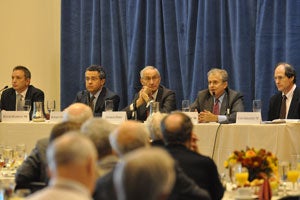With the possible departures of as many as three members of the U.S. Supreme Court’s “liberal bloc” over the next four years, appointments to the nation’s top court by the next president could have a profound impact on the Court’s makeup for decades.
On Oct. 24, a panel of four HLS professors and a lawyer/journalist examined that potential scenario as well as other possible future developments for the Supreme Court.
The panel, moderated by Dean Elena Kagan ’86, included professors David Barron ’94, Charles Fried, Cass Sunstein ’78, Laurence Tribe ’66 and New Yorker staff writer and CNN senior legal analyst Jeffrey Toobin ’86. (View webcast)
Before setting their sights on how a reconfigured court might act, panelists first dissected the current court. Although they largely agreed that the Roberts court is more conservative than the Rehnquist court, Tribe said liberal/conservative labels are misleading.
If conservatism is defined as resistance to change, “there’s nothing conservative about the four justices on the right, who have significantly dismantled significant parts of Congress’ attempts to enforce the Fourteenth Amendment, and who have invalidated key parts of the Anti-Discrimination Act, the Americans With Disabilities Act, and the Violence Against Women Act,” said Tribe.
Toobin argued that the two newest appointees, Samuel Alito and John Roberts ’79, are consciously seeking to achieve a specific conservative agenda.
“I think this is a project that conservatives have had—to overrule Roe v. Wade, to get rid of affirmative action, to expand the use of the death penalty, to expand executive power, to reduce the separation between church and state,” said Toobin. “It’s a project, and Roberts and Alito are part of the project.”
Panelists said that if Obama wins the presidency and Democrats consolidate their Congressional power, it will set the stage for a conflict with the Supreme Court.
“I think this clash will be quite significant,” Barron said.
Fried said he believes that one of the looming battles that could emerge as a point of difference between Congress and the Supreme Court could be free speech—but there could be an unusual reversal of roles occurring, with Democrats seeking curtailment.
“Whether it has to do with broadcasting, campaign speech, hate speech, harassing speech in the workplace, they’re not predictably lining up left and right now,” he said. “I think there will be, in a strongly regulatory Democratic Congress, a push to restrict speech in order to make the liberal agenda they’ll be enacting more feasible.”
Tribe predicted another clash will occur in the area of individual rights, including abortion and same-sex marriage. Toobin predicted a clash in the event of Congressional tort reform legislation limiting the ability of individuals to sue companies.
“The court is very much engaged in a project, mostly by conservative justices—but even Stephen Breyer [’64] is on board with this,” he said. “Even a Democrat can’t be clear on what side they’ll take on this.”
Panelists said that a McCain presidency would almost certainly strengthen the rightward tilt of the court while an Obama presidency could mean an approximate continuation of the current court’s make-up—on the premise that he would nominate liberal justices to replace looming retirees John Paul Stevens, who is 88 years old, Ruth Bader Ginsburg ’56-’58, who is 75, and David H. Souter ’66, who is 69.
